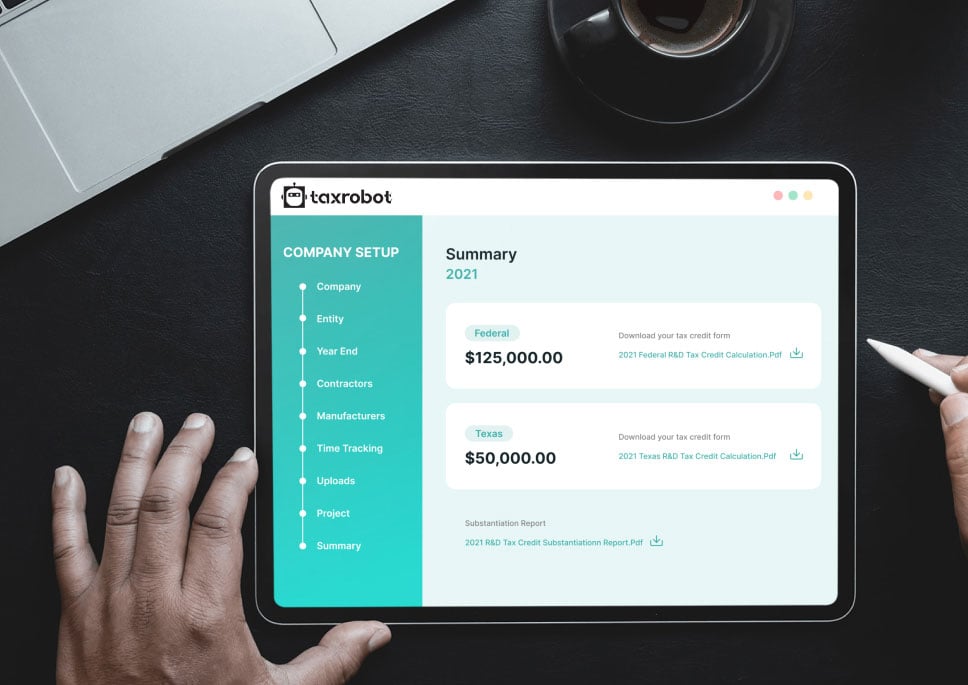New Mexico R&D Tax Credit
With TaxRobot, New Mexico R&D Tax Credit becomes more than a benefit—it becomes a catalyst for your business growth. Unleashing the incredible, simplifying the complex. This is not just tax planning; it’s financial evolution.
Maximize your State Credits today!
Put the R&D tax credit process on autopilot.
Trusted By:








New Mexico R&D Tax Credit
Discover your eligibility for New Mexico R&D tax credits and supercharge your enterprise.
New Mexico R&D Tax Credit: Maximize Your Refunds with TaxRobot
Welcome to TaxRobot, your go-to solution for maximizing your New Mexico R&D Tax Credits. In the ever-changing landscape of tax incentives, we understand the importance of staying ahead and leveraging every opportunity to boost your business.
That’s why we’re here to simplify the process and ensure you receive the largest refunds possible. With our AI-powered R&D Tax Software, you can say goodbye to tedious calculations and hello to efficiency.
Our team of subject matter experts, armed with years of experience, has already delivered millions of dollars in tax credits to clients nationwide.
Understanding New Mexico R&D Tax Credits
At TaxRobot, we believe that understanding the ins and outs of New Mexico’s R&D Tax Credits is essential for businesses looking to maximize their benefits. The Technology Jobs and R&D Tax Credit Act, revised in 2016, provides incentives for the research and development of small businesses. Companies must make approved expenditures for sanctioned research at an authorized facility to be eligible.
Qualified expenditures include depletable land, rent, facility operation and maintenance costs, buildings, equipment, computer software, payroll, and more. However, it’s important to note that certain exclusions apply to specific expenditures.
The tax credits available in New Mexico include the R&D Small Business Tax Credit and the Technology Jobs and R&D Tax Credit. The latter consists of the Basic Technology Jobs Tax Credit and the Additional Technology Jobs Tax Credit, which can be applied against personal or corporate income tax.
Businesses need to meet specific criteria such as employment and revenue thresholds and a minimum percentage of qualified research expenditures to qualify as a Qualified R&D Small Business.
Our team at TaxRobot is well-versed in the intricacies of New Mexico’s R&D Tax Credits, ensuring that you have a comprehensive understanding of the program and can make the most of your eligible expenses.
Simplified R&D Tax Credit Process with TaxRobot
TaxRobot is dedicated to simplifying the R&D tax credit process, making it seamless and efficient for businesses.
Our three-step approach streamlines the entire journey.
- You provide the necessary information about your R&D activities and expenses.
- We seamlessly link our system with your existing financial and operational systems, ensuring smooth data integration.
- We handle the rest, utilizing our advanced algorithms to calculate your tax credit and facilitate the refund process accurately.
Our intelligent algorithms are designed to save you valuable time. By automating complex calculations and eliminating manual data entry, TaxRobot allows you to focus on what matters most – running your business and driving innovation.
When it comes to pricing, we believe in transparency and fairness. TaxRobot follows a value-based pricing model, which means you only pay a fee if you receive a tax credit. We are committed to providing exceptional value while aligning our success with yours.
TaxRobot Audit Support and Superior Documentation
At TaxRobot, we understand that audits can be a concern for businesses. That’s why we are committed to providing comprehensive audit support to our clients. Our team of experts is well-equipped to handle any audit-related questions or requests that may arise, ensuring a smooth and stress-free process for you.
In addition to our audit support, TaxRobot prides itself on delivering superior documentation that satisfies statutory and IRS-recommended reporting requirements. Our software generates detailed and accurate reports, providing the necessary documentation to support your R&D tax credits.
With TaxRobot, you can have peace of mind knowing that your documentation is thorough, reliable, and audit-proof.
Maximize Your New Mexico R&D Tax Credits With TaxRobot
When it comes to maximizing your New Mexico R&D Tax Credits, TaxRobot is your trusted partner. Our AI-powered R&D Tax Software simplifies the process, allowing you to focus on your core business operations.
With our expertise, value-based pricing, and commitment to delivering larger refunds compared to competitors, TaxRobot is the solution you need.
From fast onboarding to seamless integration and accurate calculations, our three-step process ensures a hassle-free experience. We provide audit support, handle complex questions, and offer superior documentation that meets reporting requirements.
With TaxRobot, you can confidently navigate the world of R&D tax credits, unlocking the full potential of your business.
Take a sneak peak

- Limited Time Offer
- Simple Onboarding
- Easy to Use
R&D Tax Credits FAQs
The four-part test as outlined in the Internal Revenue Code is used to determine qualified R&D activity.
The Four-Part Test
1). New Or Improved Business Component
Creation of a new product, process, formula, invention, software, or technique; or improving the performance, functionality, quality, or reliability of existing business component.
- Construction of new buildings or renovation of existing buildings
- Invention of a software application
- Manufacturing of a new product or the improvement of the production process for an existing product
- Creation of design documentation
2). Technological In Nature
The activity fundamentally relies on principles of the physical or biological sciences, engineering, or computer science. A taxpayer does not need to obtain information that exceeds, expands or refines the common knowledge of skilled professionals in a particular field.
- Physics (relationship between mass, density and volume; loading as the
result of gravitational attraction) - Engineering (mechanical, electrical, civil, chemical)
- Computer science (theory of computation and design of computational systems)
3). Elimination Of Uncertainty
Uncertainty exists if the information available to the taxpayer does not establish the capability or method for developing or improving the business component, or the appropriate design of the business component.
- The capability of a manufacturer to create a part within the specified tolerances
- The appropriate method of overcoming unsuitable soil conditions during construction
- The appropriate software design to meet quality and volatility requirements
4). Process Of Experimentation
A process designed to evaluate one or more alternatives to achieve a result where the capability or method of achieving that result, or the appropriate design of that result, is uncertain as of the beginning of the taxpayer’s research activities.
- Systematic process of trial and error
- Evaluating alternative means and methods
- Computer modeling or simulation Prototyping Testing
The R&D tax credit is one of the most misunderstood tax incentives available. Considering the myriad of industries and activities that legally qualify for the credit, the term “research and development” is a misnomer. Additionally, the R&D tax credit requires specialized knowledge and technology to identify and calculate the incentive properly.
Companies of various industries are unaware that they are eligible to claim the R&D tax credit. Under the Internal Revenue Code’s definition of R&D, many common activities qualify. You can get tax benefits for industries including software, technology, architecture, engineering, construction, manufacturing, and more.
The R&D tax credit can be claimed for all open tax years. Generally, open tax years include the prior three tax years due to the statute of limitations period. In certain circumstances, the law allows businesses to claim the R&D tax credit for an extended period of time. It is common for companies to amend previous tax years to claim this benefit and reduce the maximum amount of tax liability.
Partnerships and S corporations must file this form to claim the credit. The credit will flow from the Form 6765, to the Schedule K-1, to the Form 3800 on the individual’s tax return. For individuals receiving this credit that have ownership interest in a partnership or S corporation, Form 6765 is not required on the individual return.
Individuals claiming this credit can report the credit directly on Form 3800, General Business Credit if their only source for the credit is a partnership, S corporation, estate, or trust. Otherwise, Form 6765 must be filed with the individual’s tax return (e.g. sole proprietorship).
For tax years prior to 2016, the credit can be used to reduce the taxpayer’s regular tax liability down to the tentative minimum tax. The credit cannot be used to offset alternative minimum tax. Beginning in tax year 2016, eligible small businesses have expanded utilization for the credit. For these eligible small businesses, the regular tax liability can offset alternative minimum tax using the “25/25” rule.
What our customers have to say
I highly recommend TaxRobot to anyone considering an R&D Tax Credit software to complete their analysis.

We decided to switch to TaxRobot… Best decision we’ve ever made. More affordable, and less complicated.

I couldn’t believe how easy it was! In under an hour, we saved enough money to hire a new employee.
